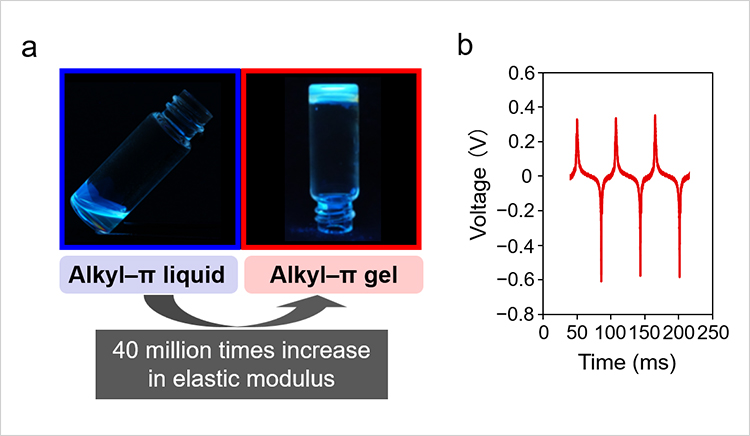A research group led by Mr. Akito Tateyama, a doctoral student in the Division of Soft Matter at the Graduate School of Life Science of Hokkaido University, Dr. Takashi Nakanishi, a visiting professor at the Graduate School of Life Science of Hokkaido University, Dr. Kazuhiko Nagura, a researcher at National Institute for Materials Science (NIMS), and Dr. Masamichi Yamanaka, a professor at Meiji Pharmaceutical University has developed a gel electret capable of stably retaining a large electrostatic charge. The team then combined this gel with highly flexible electrodes to create a sensor capable of perceiving low-frequency vibrations (e.g., vibrations generated by human motion) and converting them into output voltage signals. This device may potentially be used as a wearable healthcare sensor.
Interest in developing soft, lightweight, power-generating materials has been growing in recent years for soft electronics designed for various purposes, such as healthcare and robotics. Electret materials capable of stably retaining electrostatic charge may be used to develop vibration-powered devices without external power sources. NIMS has been leading efforts to develop a low-volatility, room-temperature alkyl–π liquid composed of a π-conjugated dye moiety and flexible yet branched alkyl chains (a type of hydrocarbon compound). The alkyl–π liquids exhibit excellent charge retention properties, can be applied to other materials (e.g., through painting and impregnation), and are easily formable. However, when these liquids have been combined with electrodes to create flexible devices, they have proven difficult to immobilize and seal, resulting in leakage issues. Moreover, the electrostatic charge retention capacities of alkyl–π liquids needed to be increased in order to improve their power generation capabilities.
The research team recently succeeded in creating an alkyl–π gel by adding a trace amount of a low-molecular-weight gelator to an alkyl–π liquid. The elastic storage modulus of this gel was found to be 40 million times that of its liquid counterpart, and it could be simplified fixation and sealed. Moreover, the gel-electret obtained by charging this gel achieved a 24% increase in charge retention compared to the base material (i.e., the alkyl–π liquid), thanks to the improved confinement of electrostatic charges within the gel. The team combined flexible electrodes with the gel-electret to create a vibration sensor. This sensor could perceive vibrations with frequencies as low as 17 Hz and convert them into an output voltage of 600 mV—83% higher than the voltage generated by an alkyl–π liquid electret-based sensor.
In future research, the team aims to develop wearable sensors capable of responding to subtle vibrations and various strain deformations by further improving the charging electret characteristics (i.e., charge capacity and charge life) and strength of the alkyl–π gel. Additionally, since this gel is recyclable and reusable as a vibration sensor material, its use is expected to help promote a circular economy.
The results of this research were published online in Angewandte Chemie International Edition on April 11, 2024.

Original Article
Alkyl–π Functional Molecular Gels: Control of Elastic Modulus and Improvement of Electret Performance
Akito Tateyama, Kazuhiko Nagura, Masamichi Yamanaka, Takashi Nakanishi
Angew. Chem. Int. Ed. 2024, 63 (20), e202402874.
https://doi.org/10.1002/anie.202402874
Related Site
National Institute for Materials Science (NIMS) Press Release
![]()
![]()
![]()